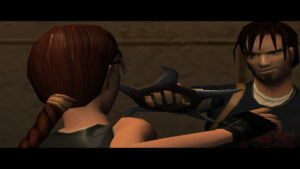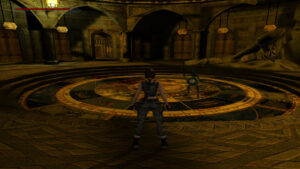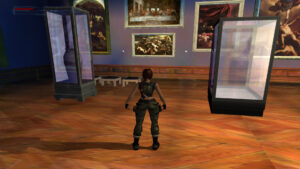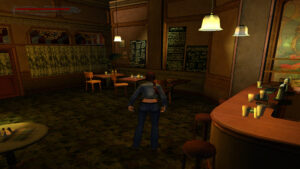TR6: End of an Era
What’s your least favorite part of Tomb Raider?
Is it the water levels, making you search desperately for the next air pocket while using a less familiar control scheme? Or maybe it’s the boss fights, making you figure out puzzles while constantly distracting you by chasing you around? Perhaps it’s the parts where you pull a lever to open a door, but it only opens for a little while, forcing you to do a difficult sequence of jumps within a tight time limit and start over whenever you fail?
Well, whatever your preference, the last few levels of Tomb Raider: The Angel of Darkness have got you covered.
The final boss fight against Eckhardt actually isn’t all that bad — my only complaint about it is that you spend a lot of time waiting through phases where Eckhardt isn’t attacking or vulnerable — but it’s preceded by a far more aggravating one, where Kurtis, now allied with Lara for the moment, battles a huge insectoid abomination that spits acid. Being hit by an acid missile makes Kurtis flinch, which makes it harder to dodge the next missile — a classic “stun lock” effect. And at the end of it, Kurtis appears to die a cutscene death, making me wonder why I just put in so much effort to keep him alive. But really, it only took me so many tries because, even after playing for so many hours, I still didn’t fully understand the controls. The monster has multiple targetable spots, which you have to switch between, and the game is generally light enough on combat that this was the first time I ever needed to use the “switch targets” button.
On a positive note, there are some really good sets throughout this section. The twisty catwalks above the marine biology area are like a satisfyingly explorable jungle gym, and Eckhardt’s old alchemical laboratory is full of first-rate atmospheric knick-knacks.
The ending is a bit of a confusing mess, though, and I’m guessing it’s a big part of why the game got a reputation as rushed and unfinished. Specifically, a character who I don’t recall ever seeing before, but who Lara recognizes, reveals himself to be a nephil shape-shifter, and the real identity behind every single person who helped Lara throughout the game, including Kurtis. The more I think about this, the less sense it makes. Kurtis has a bio on various wikis. He has a backstory. Apparently there were plans to spin him off into his own games if he was popular enough — and no surprise there, that was pretty obvious from the moment he appeared onscreen. And yet here the game is, implying that he was never a real person. Maybe some of his appearances were the real Kurtis and some were the shape-shifter? I’m mulling over the possible combinations, and I don’t see one that works.
At any rate, I’m not the only one with criticisms like these. This game was enough of a critical failure to kill the original Tomb Raider continuity. Lara’s next game is a reboot, made by a different studio. This seems like a good opportunity to close the book on her adventures for a little while.
 Comments(0)
Comments(0)


